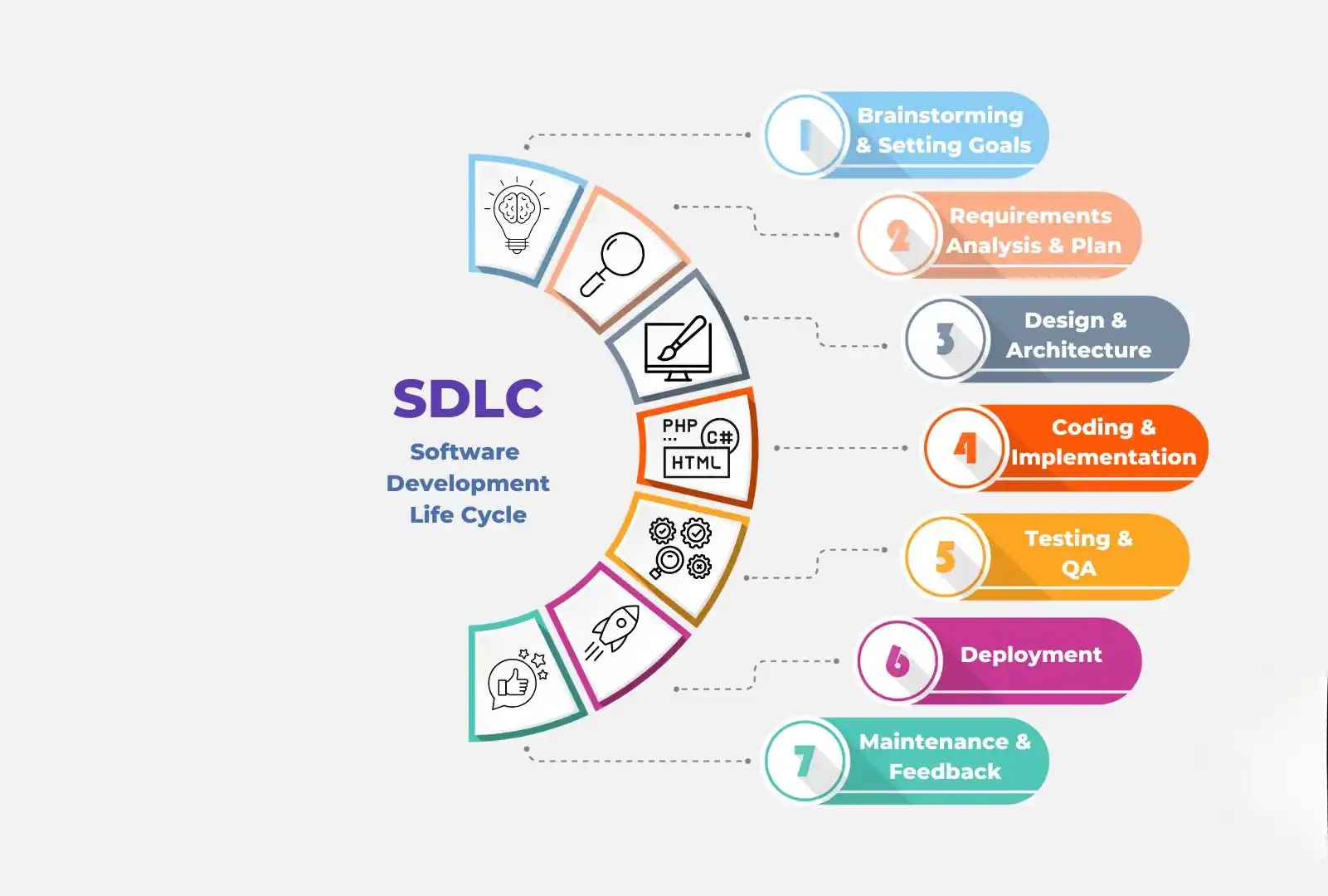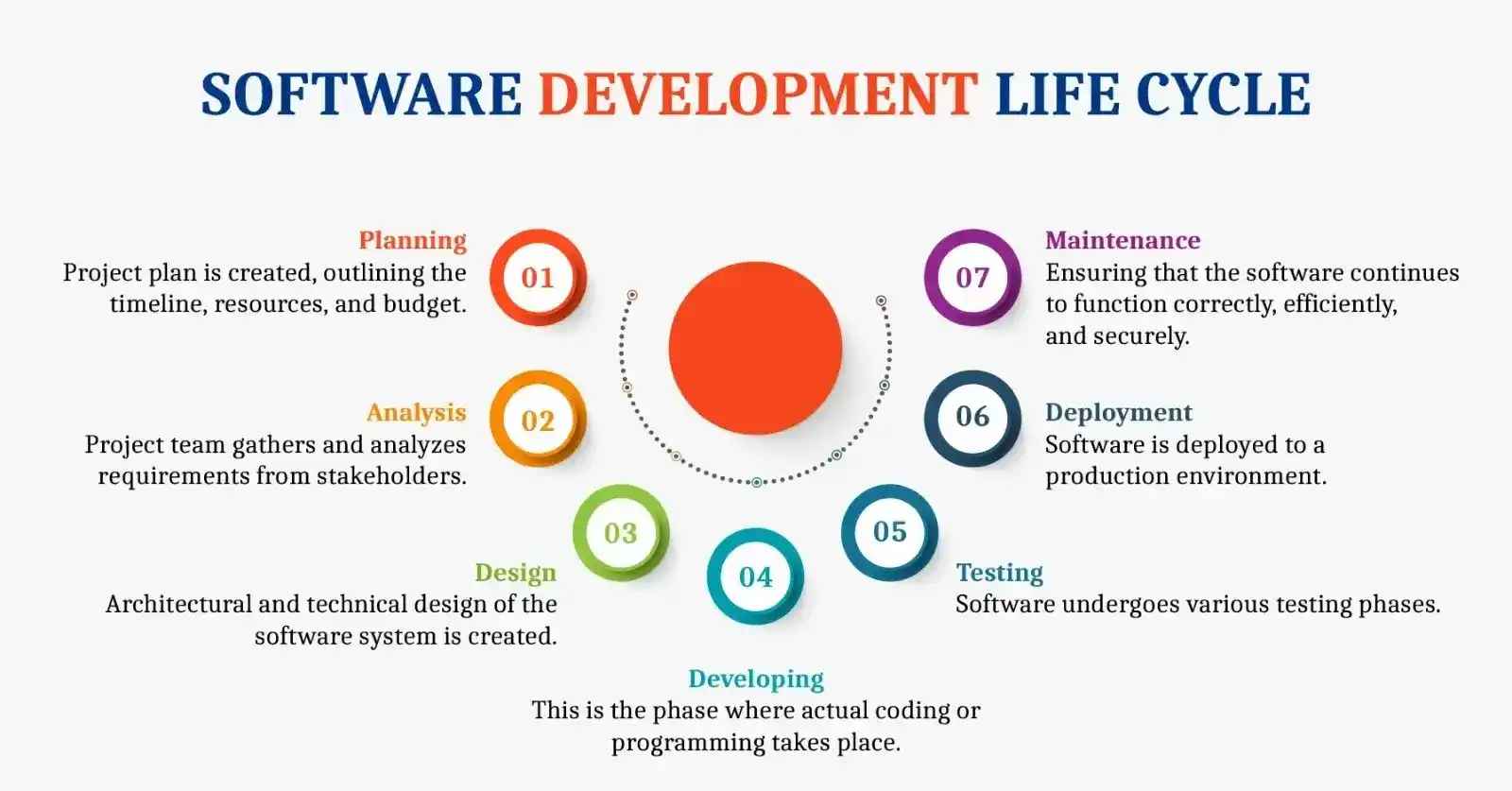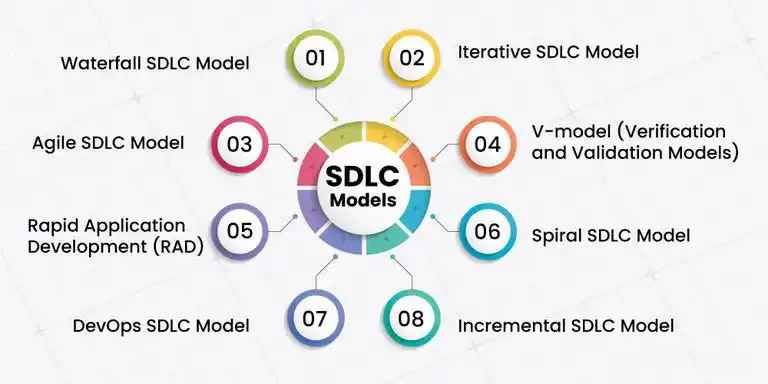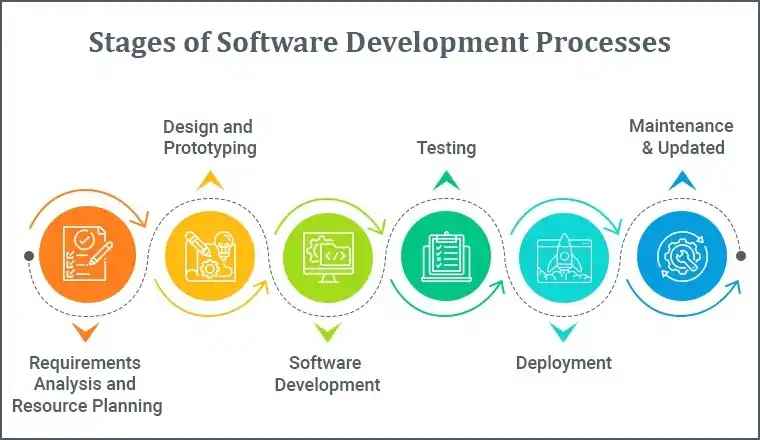Steps in SDLC Life Cycle: Plan, Analyze, Design, Build, Test
Updated on : 16 April 2025

Image Source: google.com
Table Of Contents
Introduction
The SDLC is the blueprint for creating quality software. From 📝 planning and 📊 analyzing to 🎨 designing, 🛠️ building, and 🧪 testing, each step ensures the end product is efficient, reliable, and ready for users. Quality at every phase!
Software Development Life Cycle (SDLC)
| Phase | Description | Purpose |
|---|---|---|
| Planning | Define project scope, objectives, and resources. | Set a clear direction for the project. |
| Analysis | Gather detailed requirements from stakeholders. | Understand user needs and system requirements. |
| Design | Create system architecture and detailed design. | Plan how the system will work and look. |
| Development | Write the code based on the design. | Build the software as per specifications. |
| Testing | Test the software for bugs and performance. | Ensure the software works as expected. |
| Deployment | Release the software for production use. | Make the software available to end-users. |
| Maintenance | Update and fix the software post-deployment. | Ensure long-term functionality and performance. |
Planning

Image Source: google
- Project Scope Definition 📏
- Clarifies the project’s boundaries and what will and won’t be included.
- Helps in setting realistic expectations for both the development team and stakeholders.
- Requirement Gathering 📋
- Collects detailed requirements from stakeholders, users, and clients.
- Involves documenting both functional (features) and non-functional (performance, security) requirements.
- Feasibility Study 💡
- Analyzes if the project is technically and financially feasible.
- Considers resources, technology, budget, and timeline to identify potential challenges early on.
- Resource Planning 🧑💻📦
- Identifies the human, technological, and financial resources required for the project.
- Assigns roles and responsibilities to team members.
- Risk Assessment ⚠️
- Analyzes potential risks that could hinder project success (e.g., scope creep, technology limitations, budget overruns).
- Creates a risk mitigation strategy to manage and minimize those risks.
- Timeline and Milestone Planning 🗓️
- Establishes the project timeline, outlining key milestones and deadlines.
- Helps in tracking progress and ensures that the project stays on schedule.
- Budget Estimation 💵
- Projects the financial costs required for development, including resources, tools, licenses, and testing.
- Ensures that the project remains within the allocated budget and avoids cost overruns.
- Stakeholder Communication Plan 📢
- Defines how and when updates will be shared with stakeholders.
- Ensures that everyone involved is informed and aligned on project progress and expectations.

Need help navigating the SDLC for your project?
Requirements Analysis
| 📜 Milestone | 📋 Description |
|---|---|
| Initial Requirement Gathering | Collecting and documenting all business and user requirements for the system. |
| Requirement Specification | Creating a detailed, clear, and agreed-upon document outlining all system requirements. |
| Feasibility Analysis | Assessing the technical, financial, and operational feasibility of the project. |
| Requirement Validation | Ensuring that the documented requirements align with stakeholder expectations. |
| Final Approval | Obtaining approval from stakeholders to proceed to the design phase. |
Design
| 📜 Milestone | 📋 Description |
|---|---|
| High-Level Design | Creating an overall system architecture and defining key components and their interactions. |
| Detailed Design | Designing detailed specifications for each system component, including interfaces and data flow. |
| Prototyping | Building a prototype to demonstrate key features or verify technical aspects of the design. |
| Design Validation | Reviewing the design with stakeholders to ensure it meets the requirements and is feasible. |
| Final Design Approval | Obtaining approval from stakeholders to move to the development phase. |
Coding
- Writing the Code 💻
- Developers start writing the code in the chosen programming languages.
- The focus is on creating clean, efficient, and maintainable code that aligns with the design documents.
- Following Coding Standards 📜
- Ensures uniformity and readability by adhering to coding guidelines.
- Helps in reducing errors and improves team collaboration.
- Version Control & Collaboration 🔄
- Using tools like Git to manage changes and collaborate with team members.
- Keeps track of code versions and facilitates easy integration of features.
- Implementing Features 🔧
- The core functionalities outlined in the planning phase are now built.
- Each feature is coded and integrated into the existing codebase.
- Debugging and Troubleshooting 🐞
- Identifying and fixing bugs or issues as they arise.
- Continuous testing is performed to catch errors early in the development process.
- Code Review and Optimization 🔍
- Reviewing the code for quality, performance, and compliance with standards.
- Refactoring and optimizing the code for efficiency and scalability.
Testing
- Testing Objectives 🎯
- The primary goal is to identify defects or bugs in the software before it’s deployed.
- Verifies if the system meets the functional and non-functional requirements as per the specifications.
- Types of Testing 🧪
- Unit Testing: Focuses on testing individual components or functions of the application.
- Integration Testing: Tests how different modules of the software interact with each other.
- System Testing: Verifies the entire system as a whole, ensuring all parts work together.
- Acceptance Testing: Confirms the software meets the business needs and is ready for deployment.
- Manual vs Automated Testing 🖱️🤖
- Manual Testing: Performed by testers to simulate real user actions and interactions with the system.
- Automated Testing: Uses tools (e.g., Selenium, JUnit) to run repetitive tests, improving efficiency and accuracy.
- Common Testing Tools 🛠️
- JUnit: Used for unit testing in Java applications.
- Selenium: Popular for automating browser-based testing.
- Postman: Used for API testing.
- JMeter: Often used for load testing and performance testing.
- Bug Tracking and Reporting 🐞
- During testing, bugs and defects are logged into a tracking system (e.g., Jira, Bugzilla).
- Testers document the severity and steps to reproduce the issue, ensuring developers can fix the bug efficiently.
- Performance Testing 🚀
- Evaluates how the software performs under different conditions (e.g., stress, load).
- Ensures the software can handle high traffic, large data, and varying user loads.
- Regression Testing 🔄
- Ensures that new code changes do not introduce new bugs or break existing features.
- Regularly performed after code changes or updates.
- User Acceptance Testing (UAT) ✔️
- The final phase of testing where end-users validate if the software meets their expectations and requirements.
- Helps ensure that the product is ready for deployment in real-world conditions.
- Test Environment Setup 🌐
- Setting up testing environments that mirror the production environment.
- Ensures that the tests are performed under realistic conditions and the results are accurate.
- Continuous Testing 🔄
- Integrated into the development process to catch issues early and continuously throughout the development lifecycle.
- Helps in Agile development methodologies for constant feedback and improvement.
Deployment
| Feature | Deployment Phase | Purpose |
|---|---|---|
| Definition | Process of making the software available for use. | Ensures the software is accessible to users in a production environment. |
| Steps | Code finalization, configuration, deployment to production. | Make the application live, accessible, and functioning for users. |
| Environment | Production environment setup (e.g., cloud, on-prem). | Ensures all resources (servers, databases) are ready. |
| Deployment Methods | Manual, automated, continuous deployment. | Automates the process to reduce errors and speed up releases. |
| Monitoring | Post-deployment monitoring for issues. | Detects bugs or performance issues that may arise in production. |
| Roll-back Strategy | Plan for reversing a deployment if issues occur. | Ensures a quick recovery in case of deployment failure. |
| Examples | Web apps, mobile apps, enterprise software. | Apps like Facebook, Twitter, enterprise CRM systems. |
| Importance | Ensures the software is accessible to users and stable. | Guarantees that users can access the final product with minimal issues. |
Maintenance
| Feature | Maintenance Phase | Purpose |
|---|---|---|
| Definition | Ongoing support after the software is deployed. | To ensure the software remains functional, updated, and secure. |
| Focus | Bug fixes, updates, and performance improvements. | Address any issues or changes post-deployment. |
| Types | Corrective, Adaptive, Perfective, Preventive. | Maintain functionality, address new requirements, and optimize. |
| Activities | Patches, upgrades, version releases. | Implementing new features, optimizing performance, fixing bugs. |
| Tools | Jira, ServiceNow, GitHub. | Tracking and managing changes, updates, and issue resolutions. |
| Importance | Ensures longevity and continuous improvement. | Keeps the software relevant, secure, and fully functional. |
| Goal | To maintain a high level of user satisfaction. | Ensure the software adapts to new environments and requirements. |

Looking to integrate advanced solutions for your software development?
Frequent SDLC Models

Image Source: google
- Waterfall Model 💧
- A linear and sequential approach where each phase must be completed before moving to the next.
- Ideal for projects with well-defined requirements that are unlikely to change.
- V-Model (Verification and Validation) ✅
- Similar to the Waterfall model but focuses on verification and validation at each stage.
- Testing phases are associated with corresponding development phases.
- Incremental Model ➕
- Software is developed and delivered in small, incremental releases.
- Each release adds functionality, making it easier to accommodate changes.
- Spiral Model 🌀
- Combines iterative development with the Waterfall model.
- Focuses on risk assessment and involves constant refinement in each cycle.
- Agile Model ⚡
- An iterative and incremental approach focused on flexibility and customer collaboration.
- Development is done in short sprints, allowing frequent feedback and adaptation.
- RAD (Rapid Application Development) Model 🚀
- Focuses on rapid prototyping and user feedback to quickly develop functional software.
- Ideal for projects with tight timelines and a need for quick development.
- DevOps Model 🤖
- A culture of collaboration between development and operations teams.
- Focuses on continuous integration, continuous delivery (CI/CD), and automation for faster releases.
Essential Steps in Software Development

Image Source: google
| 🔍 Step | 📘 Description | 📗 Purpose |
|---|---|---|
| Requirement Gathering & Analysis 📋 | Collect user needs and project requirements. | Set the foundation for functionality and scope. |
| System Design 🎨 | Create architecture, database, and UI blueprints. | Define how the software will be structured and built. |
| Coding/Development 💻 | Write the code based on design specifications. | Build the software using appropriate tools and languages. |
| Testing 🧪 | Test the software to identify and fix bugs. | Ensure the software functions correctly and meets quality standards. |
| Deployment 🚀 | Release the software for user access. | Make the software available for real-world use. |
| Maintenance 🔧 | Update and fix bugs post-deployment. | Ensure ongoing functionality and adapt to user needs. |
FAQs
Q.1. What is SDLC?
A : SDLC (Software Development Life Cycle) is a structured process used to develop software. It outlines a series of stages that guide software development from planning to deployment and maintenance.
Q.2. Why is SDLC important?
A : SDLC ensures that the software is developed in an organized manner. It helps to maintain quality, reduce risks, and improve project management by defining clear phases, roles, and timelines.
Q.3. What are the different SDLC models?
A : Some common SDLC models include Waterfall, Agile, V-Model, Spiral, Incremental, RAD, and DevOps. Each model has its own approach to development depending on project needs.
Q.4. What are the phases of SDLC?
1 Planning – Define scope and resources.
2 Analysis – Gather and analyze requirements.
3 Design – Create system architecture and design.
4 Development – Write the code and build the system.
5 Testing – Test the software for bugs and functionality.
6 Deployment – Release the software to users.
7 Maintenance – Ongoing updates and bug fixes.
Q.5. What is the difference between Waterfall and Agile SDLC?
A : Waterfall is a linear, sequential model where each phase must be completed before the next. Agile is an iterative and incremental approach, allowing for flexibility and frequent changes based on feedback.
Q.6. What is the role of testing in SDLC?
A : Testing in SDLC ensures that the software meets the requirements and functions as expected. It helps identify defects and bugs, ensuring the software is reliable and ready for deployment.
Q.7. How does SDLC help in project management?
A : SDLC provides a clear structure for managing resources, timelines, and tasks. It helps teams stay on track, avoid scope creep, and deliver quality software on time.
Q.8. What happens during the Maintenance phase?
A : In the Maintenance phase, the software is updated, improved, and fixed for bugs. It involves regular updates to adapt to new technologies, user feedback, and changing business requirements.
Q.9. Can SDLC models be combined?
A : Yes, hybrid models can be created by combining elements of different SDLC models (e.g., combining Agile and Waterfall). This allows teams to tailor the process based on project requirements.
Q.10. How does Agile SDLC work in practice?
A : Agile SDLC works in short development cycles called "sprints" where features are developed and tested incrementally. Continuous feedback from stakeholders ensures that the project evolves in response to changing needs.


